Abstract
The intrinsic contractile properties of isolated cat papillary muscles and myocardial high energy phosphate stores were examined at three levels of thyroid activity and correlated with hemodynamic measurements in the intact animal. In addition, the relationship of thyroid state to endogenous norepinephrine stores and myocardial responsiveness to certain inotropic interventions were studied. In muscles from hyperthyroid cats, the velocity of shortening and the rate of tension development were markedly augmented, while duration of active state was decreased, compared to euthyroid muscles. These findings occurred in the presence and absence of intact norepinephrine stores and over a wide range of temperature and contraction frequency. The opposite changes occurred in muscles from hypothyroid cats. Isometric tension was slightly higher in muscles from hyperthyroid and lower in muscles from hypothyroid cats. The inotropic response to both norepinephrine and strophanthidin varied inversely with the level of thyroid state and allowed all three groups of muscles to reach a common ceiling of isometric tension regardless of thyroid state. Creatine phosphate and adenosine triphosphate stores were intact at all three levels of thyroid state. Thus, the level of thyroid activity profoundly affects the intrinsic contractile state of cardiac muscle, independent of both norepinephrine stores and alterations in high energy phosphate stores, and, in addition, modifies the responsiveness of cardiac muscle to inotropic agents.
Full text
PDF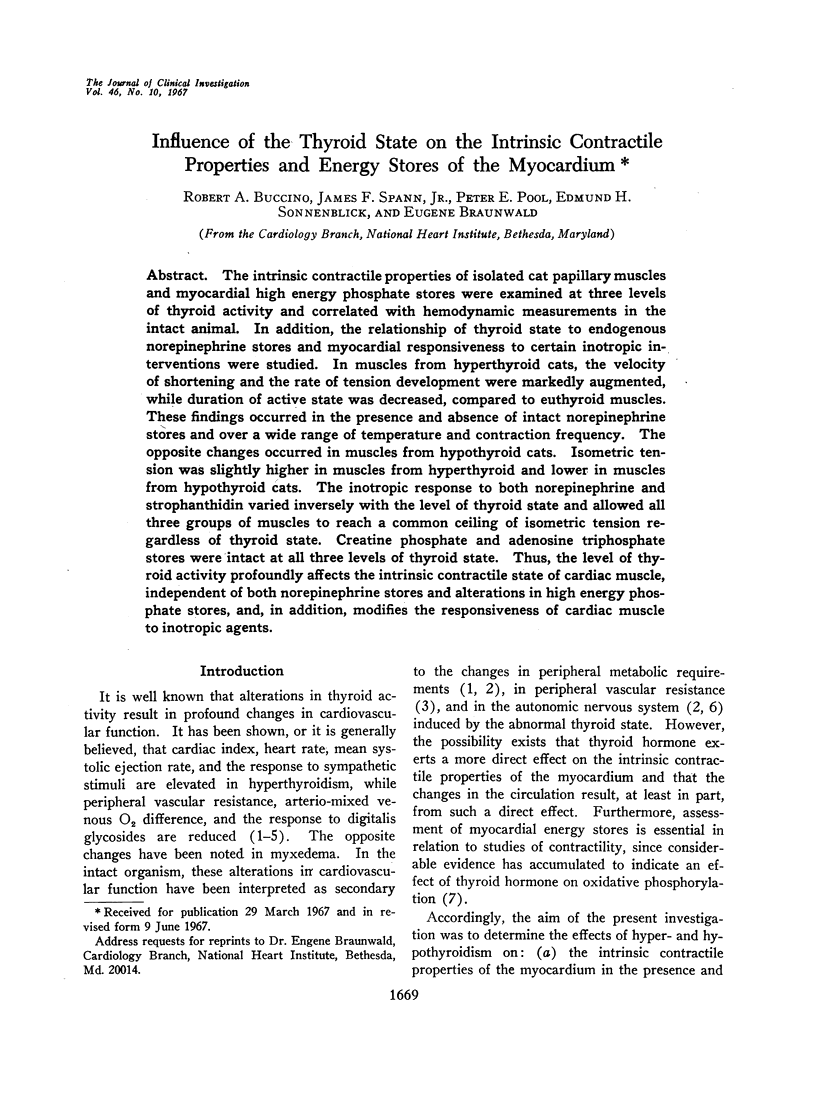
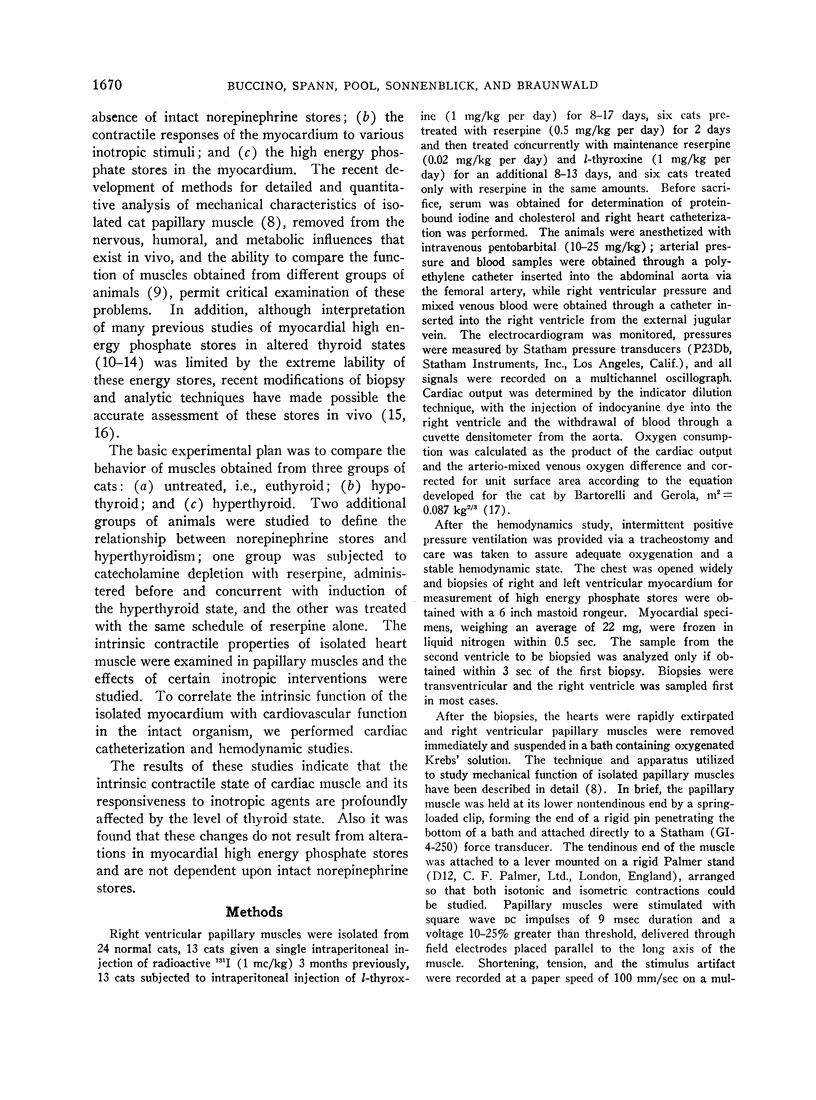
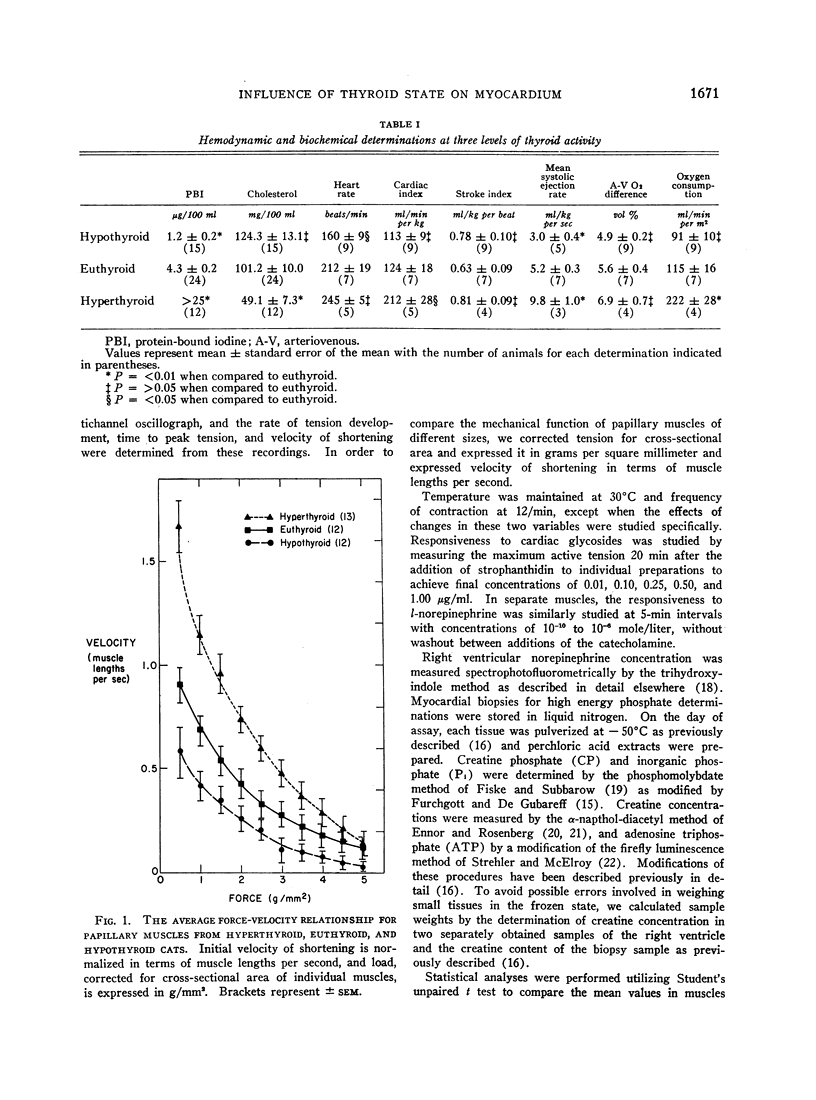
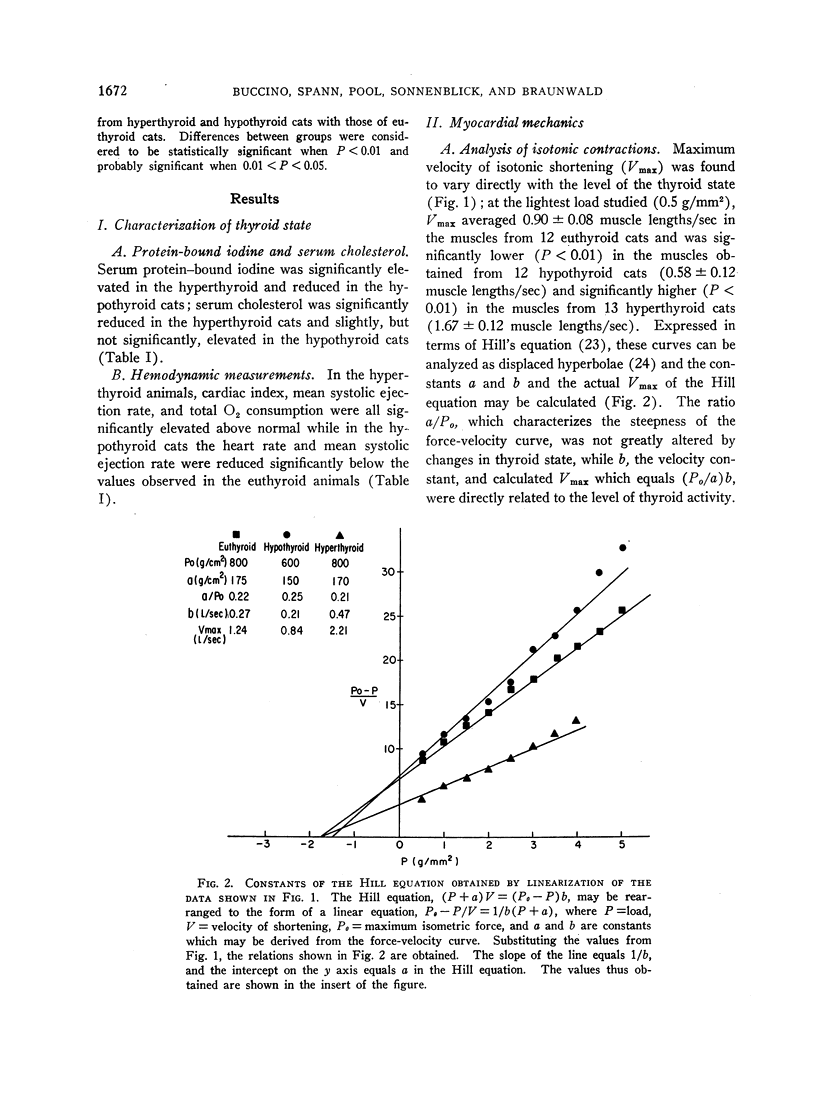
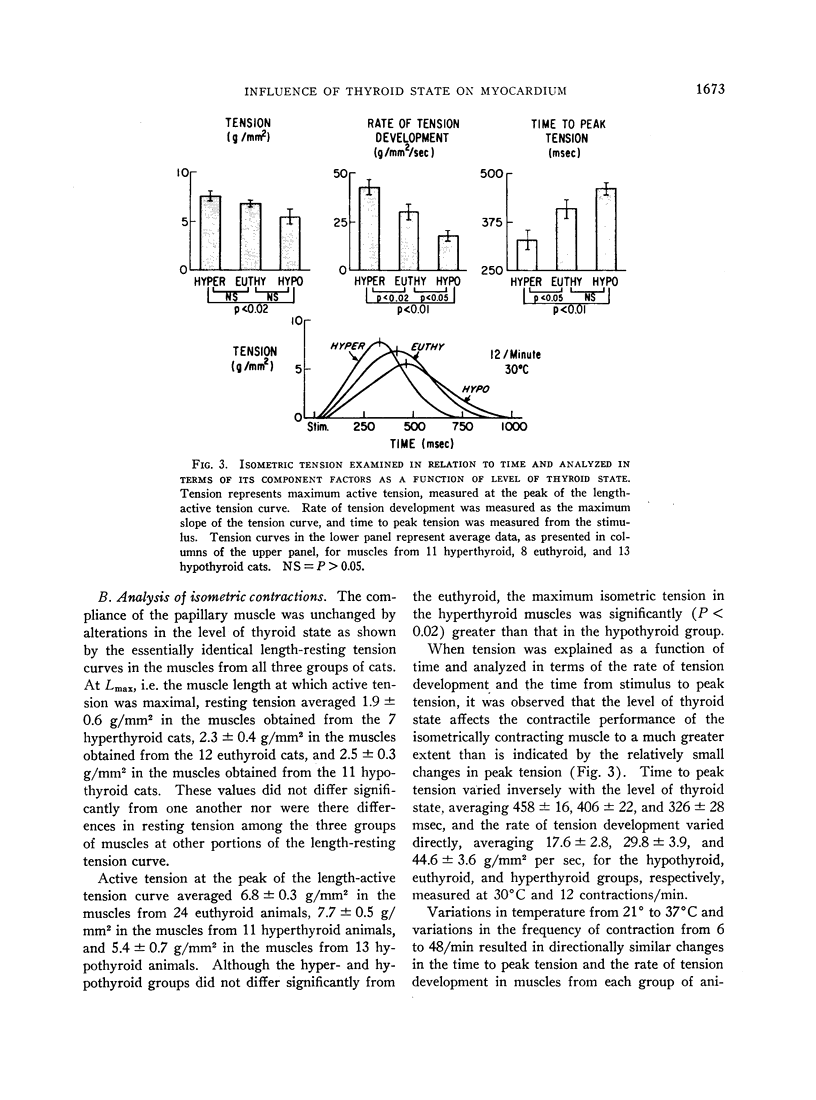
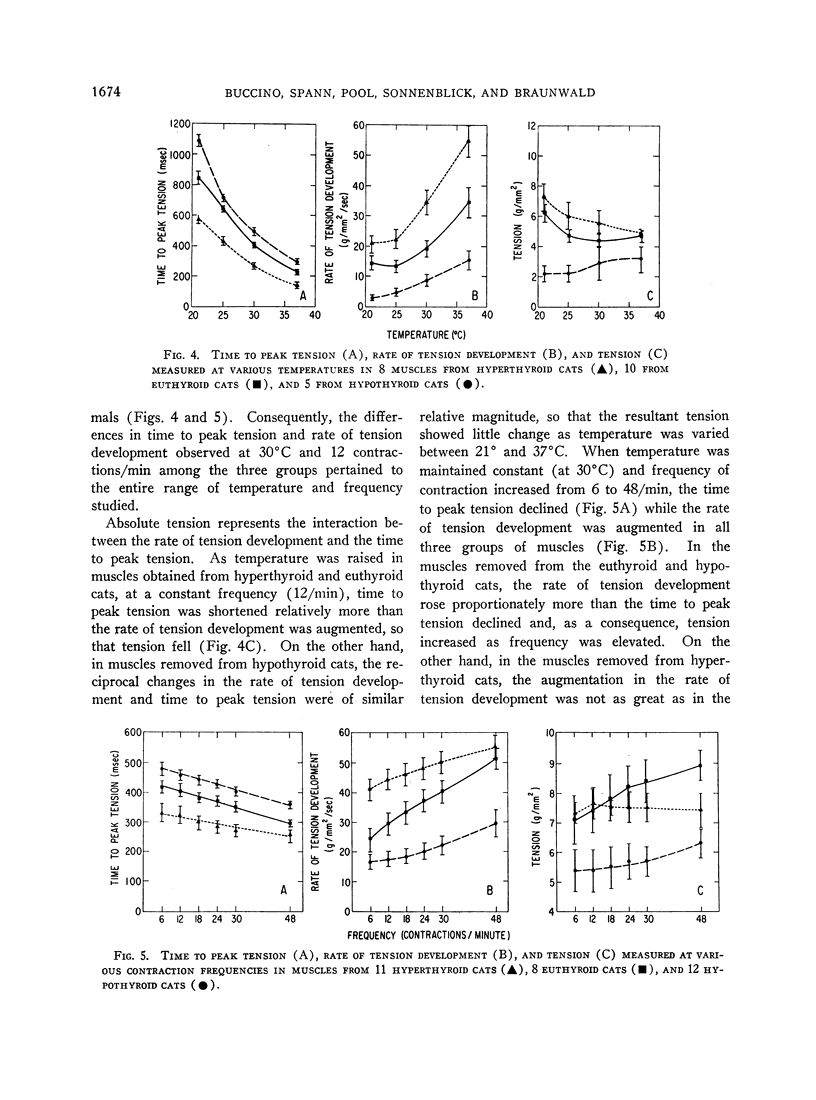
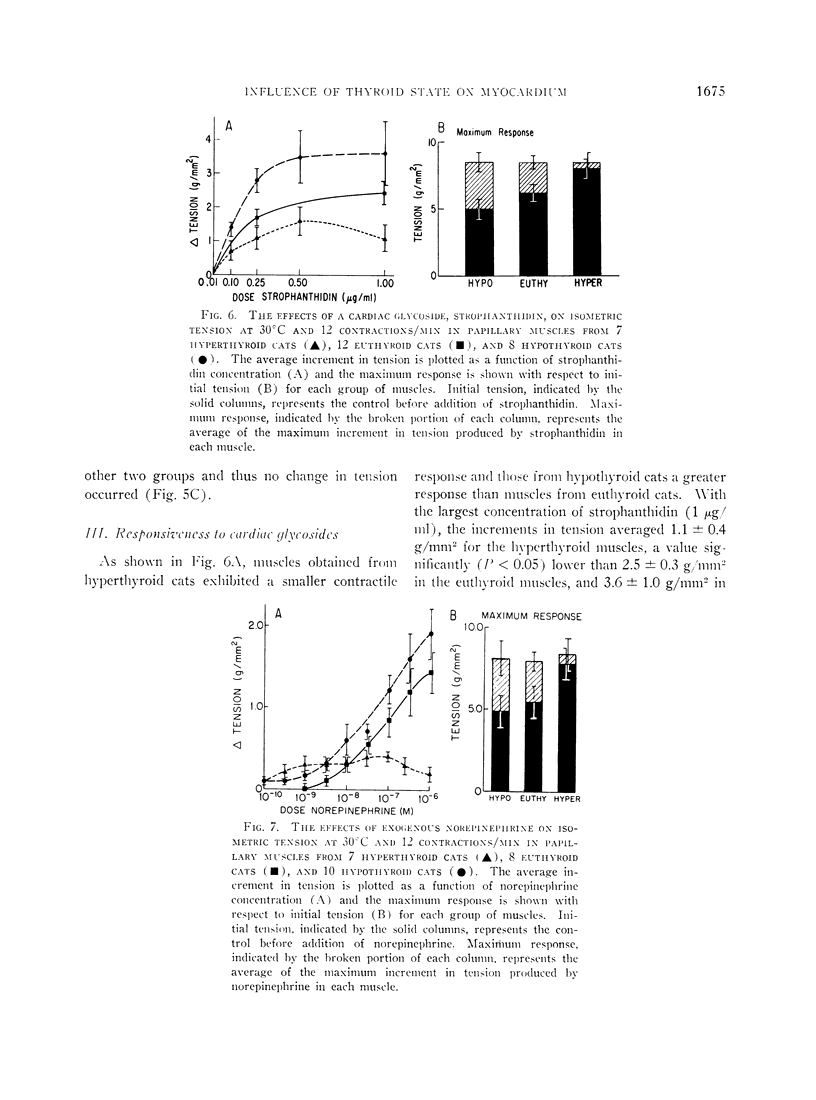
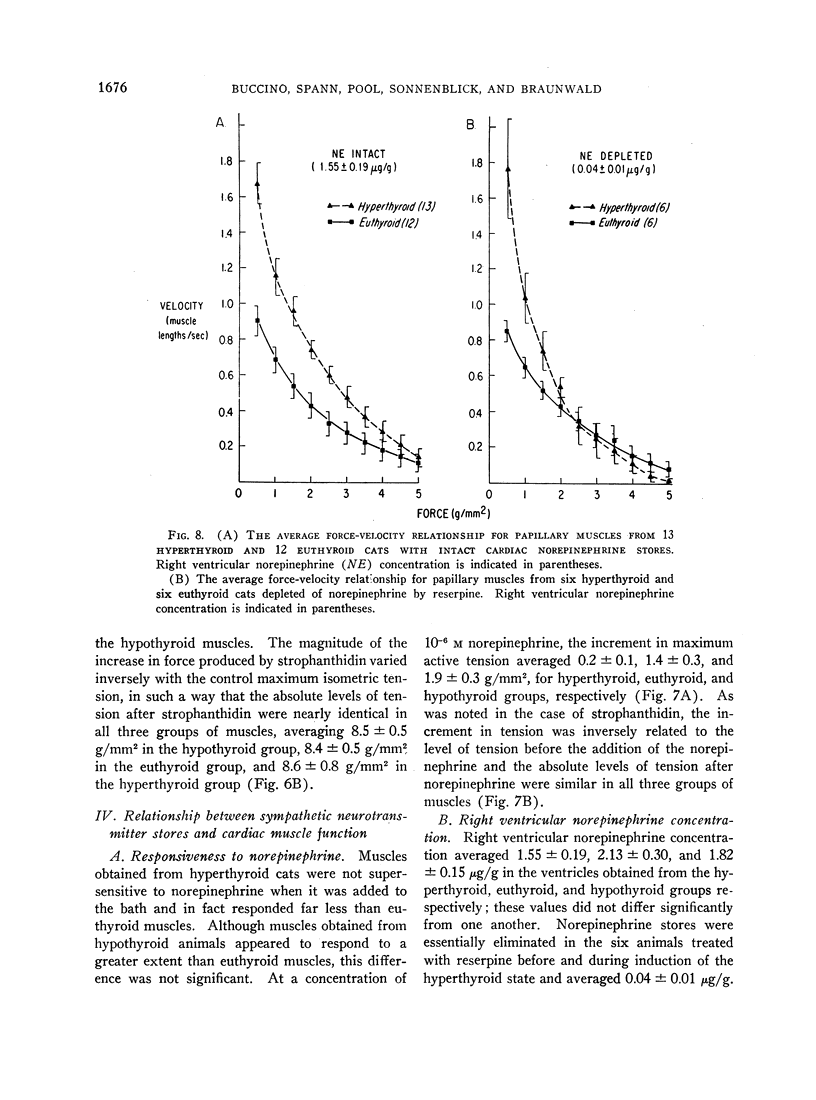
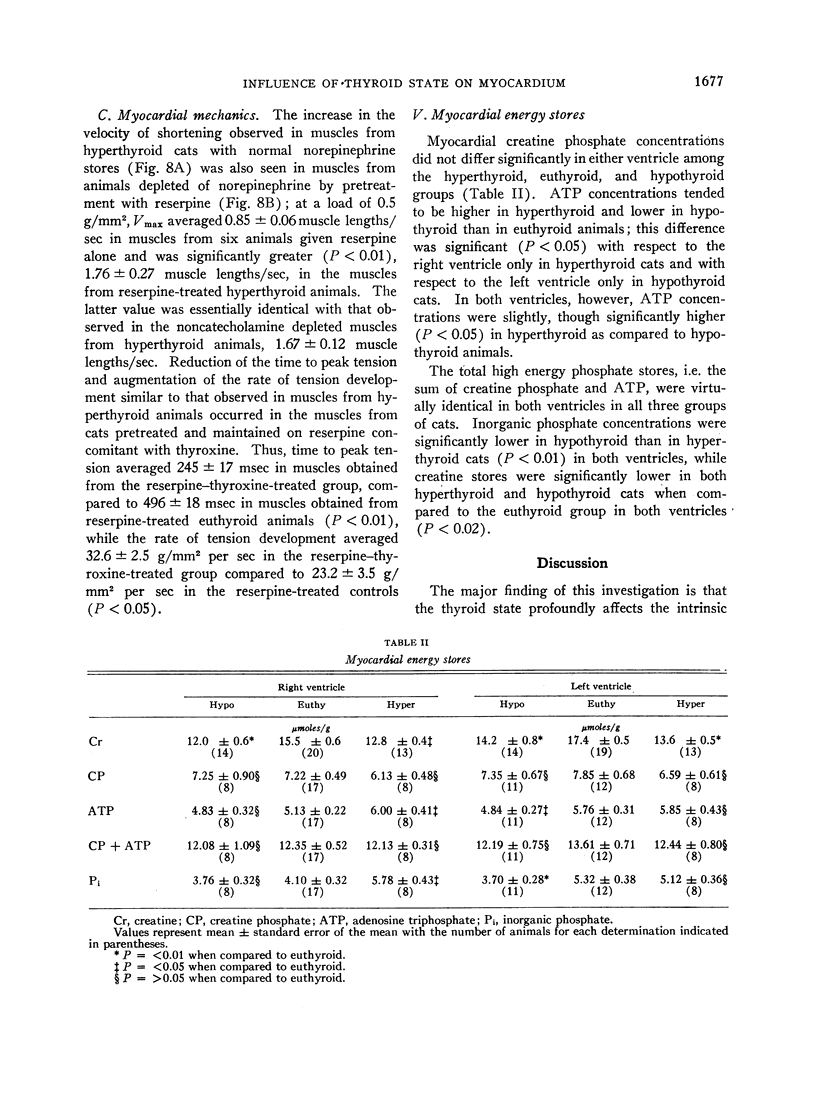
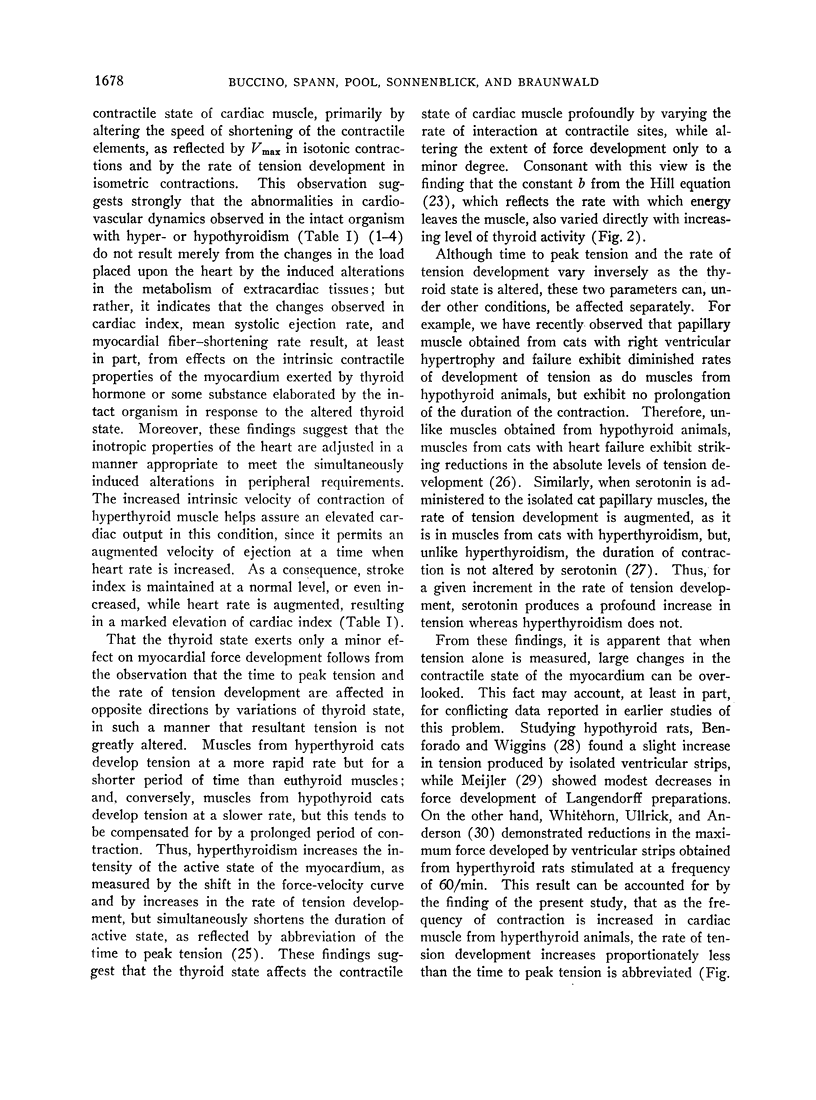
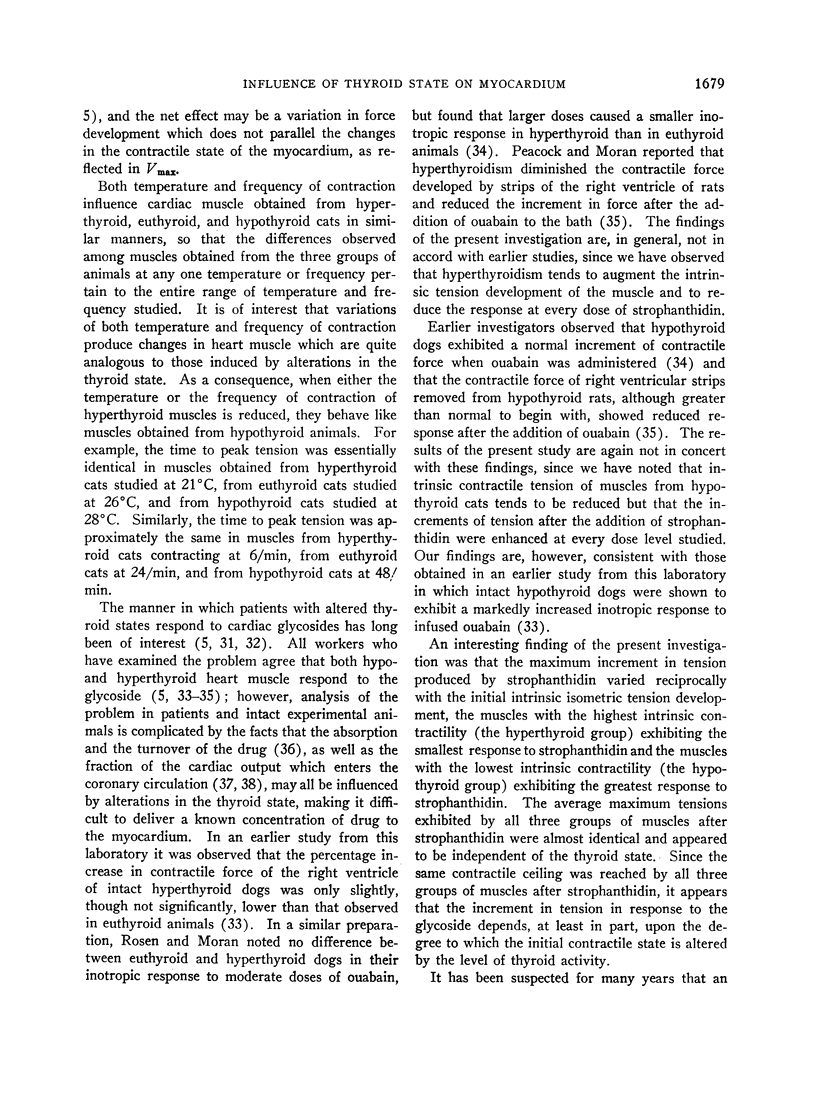
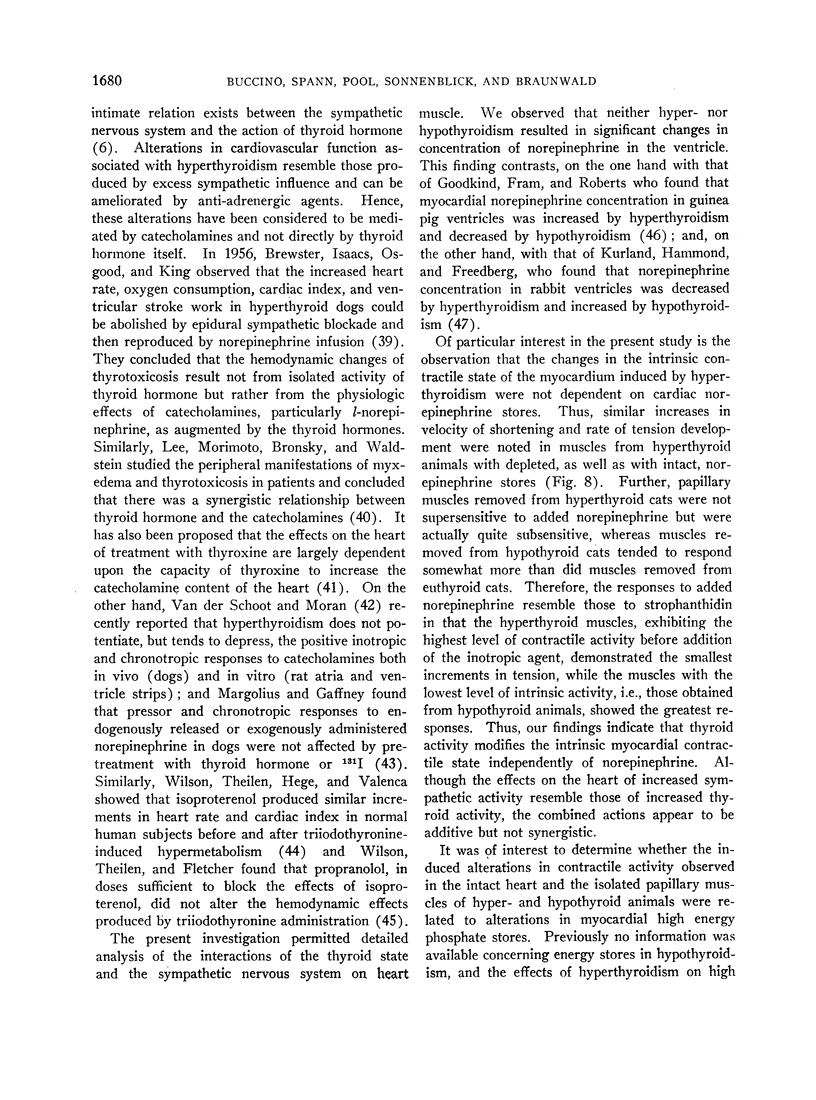
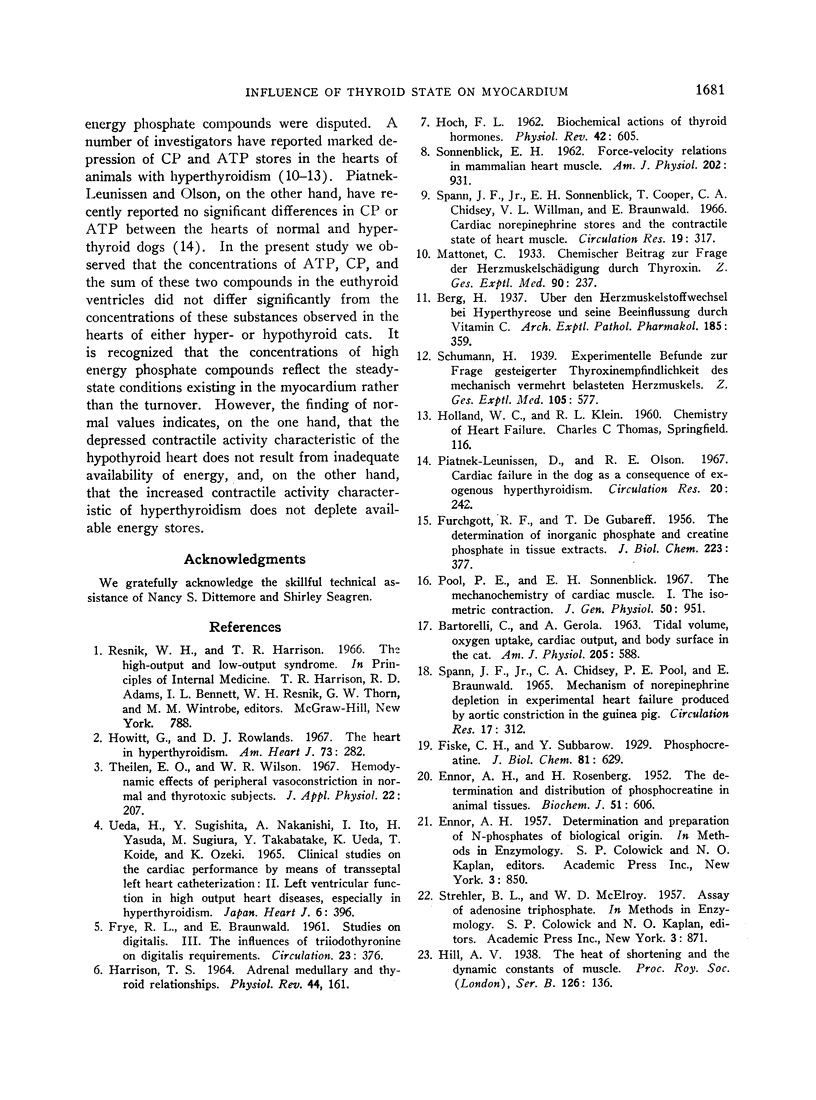

Images in this article
Selected References
These references are in PubMed. This may not be the complete list of references from this article.
- BARTORELLI C., GEROLA A. TIDAL VOLUME, OXYGEN UPTAKE, CARDIAC OUTPUT, AND BODY SURFACE IN THE CAT. Am J Physiol. 1963 Sep;205:588–590. doi: 10.1152/ajplegacy.1963.205.3.588. [DOI] [PubMed] [Google Scholar]
- BENFORADO J. M., WIGGINS L. L. CONTRACTILITY, HEART RATE, AND RESPONSE TO NOREPINEPHRINE OF ISOLATED RAT MYOCARDIUM FOLLOWING I-131-INDUCED HYPOTHYROIDISM. J Pharmacol Exp Ther. 1965 Jan;147:70–75. [PubMed] [Google Scholar]
- BING R. J. The coronary circulation in health and disease as studied by coronary sinus catheterization. Bull N Y Acad Med. 1951 Jul;27(7):407–424. [PMC free article] [PubMed] [Google Scholar]
- BREWSTER W. R., Jr, ISAACS J. P., OSGOOD P. F., KING T. L. The hemodynamic and metabolic interrelationships in the activity of epinephrine, norepinephrine and the thyroid hormones. Circulation. 1956 Jan;13(1):1–20. doi: 10.1161/01.cir.13.1.1. [DOI] [PubMed] [Google Scholar]
- CSAPO A., GOODALL M. Excitability, length tension relation and kinetics of uterine muscle contraction in relation to hormonal status. J Physiol. 1954 Nov 29;126(2):384–395. doi: 10.1113/jphysiol.1954.sp005216. [DOI] [PMC free article] [PubMed] [Google Scholar]
- DE GUBAREFF T., FURCHGOTT R. F. The determination of inorganic phosphate and creatine phosphate in tissue extracts. J Biol Chem. 1956 Nov;223(1):377–388. [PubMed] [Google Scholar]
- Doherty J. E., Perkins W. H. Digoxin metabolism in hypo- and hyperthyroidism. Studies with tritiated digoxin in thyroid disease. Ann Intern Med. 1966 Mar;64(3):489–507. doi: 10.7326/0003-4819-64-3-489. [DOI] [PubMed] [Google Scholar]
- ENNOR A. H., ROSENBERG H. The determination and distribution of phosphocreatine in animal tissues. Biochem J. 1952 Aug;51(5):606–610. doi: 10.1042/bj0510606. [DOI] [PMC free article] [PubMed] [Google Scholar]
- FRYE R. L., BRAUNWALD E. Studies on digitalis. III. The influence of triiodothyronine on digitalis requirements. Circulation. 1961 Mar;23:376–382. doi: 10.1161/01.cir.23.3.376. [DOI] [PubMed] [Google Scholar]
- GOODKIND M. J., FRAM D. H., ROBERTS M. Effect of thyroid hormone on myocardial catecholamine content of the guinea pig. Am J Physiol. 1961 Dec;201:1049–1052. doi: 10.1152/ajplegacy.1961.201.6.1049. [DOI] [PubMed] [Google Scholar]
- HARRISON T. S. ADRENAL MEDULLARY AND THYROID RELATIONSHIPS. Physiol Rev. 1964 Apr;44:161–185. doi: 10.1152/physrev.1964.44.2.161. [DOI] [PubMed] [Google Scholar]
- HOCH F. L. Biochemical actions of thyroid hormones. Physiol Rev. 1962 Oct;42:605–673. doi: 10.1152/physrev.1962.42.4.605. [DOI] [PubMed] [Google Scholar]
- Howitt G., Rowlands D. J. The heart in hyperthyroidism. Am Heart J. 1967 Feb;73(2):282–283. doi: 10.1016/0002-8703(67)90159-7. [DOI] [PubMed] [Google Scholar]
- KURLAND G. S., HAMMOND R. P., FREEDBERG A. S. RELATION OF THYROID STATE TO MYOCARDIAL CATECHOLAMINE CONCENTRATION. Am J Physiol. 1963 Dec;205:1270–1274. doi: 10.1152/ajplegacy.1963.205.6.1270. [DOI] [PubMed] [Google Scholar]
- LEE W. Y., MORIMOTO P. K., BRONSKY D., WALDSTEIN S. S. Studies of thyroid and sympathetic nervous system interrelationships. I. The blepharoptosis of myxedema. J Clin Endocrinol Metab. 1961 Nov;21:1402–1412. doi: 10.1210/jcem-21-11-1402. [DOI] [PubMed] [Google Scholar]
- Lee W. C., Lee C. Y., Yoo C. S. Effects of treatment with thyroxine on the noradrenaline content of the rabbit heart. Br J Pharmacol Chemother. 1965 Dec;25(3):651–657. doi: 10.1111/j.1476-5381.1965.tb01789.x. [DOI] [PMC free article] [PubMed] [Google Scholar]
- MCINTOSH H. D., MORRIS J. J., Jr PROBLEMS IN THE USE OF DIGITALIS IN THE MANAGEMENT OF CONGESTIVE HEART FAILURE. Prog Cardiovasc Dis. 1965 Jan;7:360–386. doi: 10.1016/s0033-0620(65)80027-5. [DOI] [PubMed] [Google Scholar]
- MEIJLER F. L. CONTRACTILITY OF ISOLATED HEARTS FROM MYXEDEMATOUS RATS. Isr Med J. 1963 Nov-Dec;22:395–404. [PubMed] [Google Scholar]
- Margolius H. S., Gaffney T. E. The effects of injected norepinephrine and sympathetic nerve stimulation in hypothyroid and hyperthyroid dogs. J Pharmacol Exp Ther. 1965 Sep;149(3):329–335. [PubMed] [Google Scholar]
- PEACOCK W. F., 3rd, MORAN N. C. Influence of thyroid state on positive inotropic effect of ouabain on isolated rat ventricle strips. Proc Soc Exp Biol Med. 1963 Jul;113:526–530. doi: 10.3181/00379727-113-28417. [DOI] [PubMed] [Google Scholar]
- Piatnek-Leunissen D., Olson R. E. Cardiac failure in the dog as a consequence of exogenous hyperthyroidism. Circ Res. 1967 Feb;20(2):242–252. doi: 10.1161/01.res.20.2.242. [DOI] [PubMed] [Google Scholar]
- Pool P. E., Sonnenblick E. H. The mechanochemistry of cardiac muscle. I. The isometric contraction. J Gen Physiol. 1967 Mar;50(4):951–965. doi: 10.1085/jgp.50.4.951. [DOI] [PMC free article] [PubMed] [Google Scholar]
- ROWE G. G., HUSTON J. H., WEINSTEIN A. B., TUCHMAN H., BROWN J. F., CRUMPTON C. W. The hemodynamics of thyrotoxicosis in man with special reference to coronary blood flow and myocardial oxygen metabolism. J Clin Invest. 1956 Mar;35(3):272–276. doi: 10.1172/JCI103273. [DOI] [PMC free article] [PubMed] [Google Scholar]
- SONNENBLICK E. H. Force-velocity relations in mammalian heart muscle. Am J Physiol. 1962 May;202:931–939. doi: 10.1152/ajplegacy.1962.202.5.931. [DOI] [PubMed] [Google Scholar]
- Sonnenblick E. H. Active state in heart muscle. Its delayed onset and modification by inotropic agents. J Gen Physiol. 1967 Jan;50(3):661–676. doi: 10.1085/jgp.50.3.661. [DOI] [PMC free article] [PubMed] [Google Scholar]
- Spann J. F., Jr, Chidsey C. A., Pool P. E., Braunwald E. Mechanism of norepinephrine depletion in experimental heart failure produced by aortic constriction in the guinea pig. Circ Res. 1965 Oct;17(4):312–321. doi: 10.1161/01.res.17.4.312. [DOI] [PubMed] [Google Scholar]
- Spann J. F., Jr, Sonnenblick E. H., Cooper T., Chidsey C. A., Willman V. L., Braunwald E. Cardiac norepinephrine stores and the contractile state of heart muscle. Circ Res. 1966 Aug;19(2):317–325. doi: 10.1161/01.res.19.2.317. [DOI] [PubMed] [Google Scholar]
- Theilen E. O., Wilson W. R. Hemodynamic effects of peripheral vasoconstriction in normal and thyrotoxic subjects. J Appl Physiol. 1967 Feb;22(2):207–210. doi: 10.1152/jappl.1967.22.2.207. [DOI] [PubMed] [Google Scholar]
- Ueda H., Sugishita Y., Nakanishi A., Ito I., Yasuda H., Sugiura M., Takabatake Y., Ueda K., Koide T., Ozeki K. Clinical studies on the cardiac performance by means of transseptal left heart catheterization. II. Left ventricular function in high output heart diseases, especially in hyperthyroidism. Jpn Heart J. 1965 Sep;6(5):396–406. doi: 10.1536/ihj.6.396. [DOI] [PubMed] [Google Scholar]
- WHITEHORN W. V., ULLRICK W. C., ANDERSEN B. R. Properties of hyperthyroid rat myocardium. Circ Res. 1959 Mar;7(2):250–255. doi: 10.1161/01.res.7.2.250. [DOI] [PubMed] [Google Scholar]
- WILSON W. R., THEILEN E. O., FLETCHER F. W. PHARMACODYNAMIC EFFECTS OF BETA-ADRENERGIC RECEPTOR BLOCKADE IN PATIENTS WITH HYPERTHYROIDISM. J Clin Invest. 1964 Aug;43:1697–1703. doi: 10.1172/JCI105045. [DOI] [PMC free article] [PubMed] [Google Scholar]
- Wilson W. R., Theilen E. O., Hege J. H., Valenca M. R. Effects of beta-adrenergic receptor blockade in normal subjects before, during, and after triiodothyronine-induced hypermetabolism. J Clin Invest. 1966 Jul;45(7):1159–1169. doi: 10.1172/JCI105422. [DOI] [PMC free article] [PubMed] [Google Scholar]
- van der Schoot J. B., Moran N. C. An experimental evaluation of the reputed influence of thyroxine on the cardiovascular effects of catecholamines. J Pharmacol Exp Ther. 1965 Sep;149(3):336–345. [PubMed] [Google Scholar]



